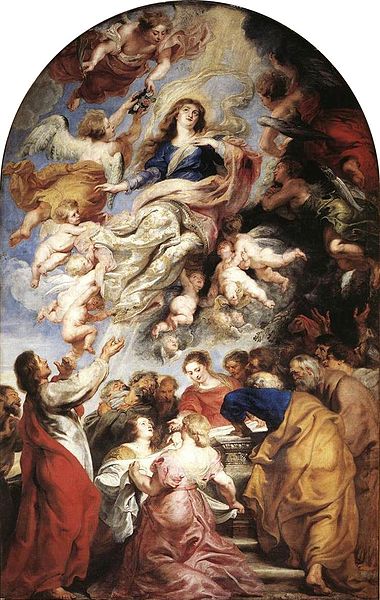A Christian Pilgrim
MAGNIFICAT: THE CANTICLE OF MARY
(A biblical reflection on the feast of THE ASSUMPTION OF THE VIRGIN MARY – Sunday, 11 August 2013)
Gospel Reading: Luke 1:39-56
First Reading: Revelation 11:19;12:1-6,10; Psalms: Psalm 45:10-12,16; Second Reading: 1Corinthians 15:20-26

The Scripture Text
In those days Mary arose and went with haste into the hill country, to a city of Judah, and she entered the house of Zechariah and greeted Elizabeth. And when Elizabeth heard the greeting of Mary, the babe leaped in her womb; and Elizabeth was filled with the Holy Spirit and she exclaimed with a loud cry, “Blessed are you among women, and blessed is the fruit of your womb! And why is this granted me, that the mother of my Lord should come to me? For behold, when the voice of your greeting came to my ears, the babe in my womb leaped for joy. And blessed is she who believed that there would be a fulfilment of what was spoken to her from the Lord.” And Mary said,
“My soul magnifies the Lord, and my spirit rejoices in God my Savior, for He has regarded the low estate of His hand maiden. For behold, henceforth all generations will call me blessed; for He who is mighty has done great things for me, and holy is His name. And His mercy is on those who fear Him from generation to generation. He has shown strength with His arm, He has put down the mighty from their thrones, and exalted those of low degree; He has filled the hungry with good things, and the rich He has sent empty away. He has helped His servant Israel, in remembrance of His mercy, as He spoke to our fathers, to Abraham and to his posterity for ever.”
And Mary remained with her about three months, and returned to her home. (Luke 1:39-56 RSV)
Mary’s canticle – the Magnificat – is a prayer of faith, just as Mary herself is a model of faith and prayer for all of us. Elizabeth confirmed this when she was moved by the Holy Spirit to cry out, “Blessed is she who believed that there would be a fulfilment of what was spoken to her from the Lord.” (Luke 1:45). Mary’s trust in God was ultimately fulfilled in the event we celebrate today, when she was taken up body and soul into heaven. Her assumption is the crowning event in the life of a humble, trusting, and prayerful woman.
The Magnificat – Mary’s hymn of praise in response to Elizabeth’s greeting – shows us some principles for our own prayer. Mary’s prayer is perhaps the most humble prayer recorded in scripture. In it, Mary acknowledged the truth about who God is and who she is before Him. The Catechism of the Catholic Church teaches that “humility is the foundation of prayer” (CCC, 2559). It certainly was the foundation of Mary’s canticle, as she confessed that God “Has regarded the low estate of His hand maiden …… for He who is mighty has done great things for me” (Luke 1:48,49).
Mary’s prayer is also one of great faith. She trusted in what God would do for her, and throughout her life remained confident of His mercy and kindness (Luke 1:50). She trusted that God would exalt the lowly of this world and that He would be faithful to all His promises (Luke 1:52-53,55). Mary’s canticle is a beautiful demonstration of the fact that we do not have to do great public deeds to please God, nor do we have to expound lengthily on deep theological issues. By following Mary’s example of loving the Lord, trusting Him, and walking humbly in His presence, we can all be pleasing to Him.
As we (you and I) come before the Lord each day in personal prayer, we must try to recall Mary’s example of humility and faith. With her, in the power of the Holy Spirit, we also will be able to declare that “God who is mighty has done great things for me; holy is His name.”
Prayer: Heavenly Father, You raised Your daughter Mary through her assumption into heaven. Help me to come before You in humility and loving trust, as she did. By the power of Your Holy Spirit, fill me with the depth of faith that Mary had. Amen
A Christian Pilgrim
ASSUMPTION, NOT ASCENSION
(A biblical reflection on the Solemnity of THE ASSUMPTION OF THE VIRGIN MARY – Sunday, 11 August 2013)

First Reading: Revelation 11:19;12:1-6,10; Psalms: Psalm 45:10-12,16; Second Reading: 1Corinthians 15:20-26; Gospel Reading: Luke 1:39-56
The Gospel for this very important day is the story of the visitation and it includes the Magnificat, Mary’s canticle.
Elizabeth can see that Mary is of all women the most blessed, and she gives as the reason, blessed is she who believed that the promise made her by the Lord would be fulfilled. The same point is emphasized by the choice of Luke 11:27-28 for the Mass of the Vigil: true blessedness is in hearing and keeping the word of God. Elizabeth praises Mary, and therefore indirectly celebrates the divine work in her.
Mary’s response to Elisabeth’s praise and blessing is to proclaim in her turn the greatness of the Lord. It is all God’s work: He has looked upon the humiliation of His servant, and as a consequence Mary can state, Yes, from now onwards all generations will call me blessed. The great things God has done for Mary are examples of His providence: faithful love for those who fear Him; the hungry filled; the arrogant routed; the promise made to the ancestors and to Abraham remembered. By the time of the Visitation the Almighty had done great things for her. The crowning gift is the Assumption.
The Magnificat ends with a cry of trust in God’s love for His people. Mary is keenly aware that the favor bestowed on her is for the entire people of God. When she said to the archangel Gabriel: “Behold, I am the handmaid of the Lord” (Luke 1:38), she fulfilled in her own person the vocation of Israel to be the servant of God (see Isaiah 41:8-10).
The loving God is faithful through the centuries; we can count on Him. If human beings are to benefit by the love of God, they must belong to the “posterity of Abraham”, not according to the flesh but according to the promise (Galatians 4:22-28), that is, they must belong to it by faith. This reference to Abraham at the end of Mary’s canticle recall Elizabeth’s greeting to her: “Blessed is she who believed that there would be a fulfilment of what was spoken to her from the Lord” (Luke 1:45). If Abraham by reason of his faith became our father, much more has Mary by her faith become our mother and mother of all those who believe in Jesus, the living Word of God, for “His steadfast love endures for ever” (Psalm 100:5).
Pope John Paul II remarks about this passage:
In her exultation Mary confesses that she finds herself in the very heart of this fullness of Christ. She is conscious that the promise made to the fathers, first of all ‘to Abraham and to his posterity for ever’ is being fulfilled in herself. She is thus aware that concentrated within herself as the Mother of Christ is the whole salvific economy, in which ‘from age to age’ is manifested He who, as the God of the Covenant, ‘remember His mercy.’ (Redemptoris Mater, 36).
We have already seen the various words that were used in earlier times, Passing (transitus), Dormition (koimēsis), and Assumption (analēpsis). In English we would distinguish theologically between assumption and ascension (normally used only of Christ, though the English liturgical texts sometimes say Mary “ascended”) and resuscitation (bringing back to life a dead corpse, as in the case of Lazarus). Mary’s assumption is glorification: she is in the final state of perfection through the resurrection of the dead.
Our reflection today is on the bodily assumption of Mary into heaven. In Mary – taken up in body and soul into complete communion with God – is revealed to what end God has called all human beings. The longing for a fulfilled life is no deception. Life with God is complete human life. Yet it is also something new that God gives to us. On this solemnity we proclaim our faith that Jesus Christ has come so that we might have life and have it abundantly (see John 10:10).
Sources: (1) Fr. Christopher O’Donnell O.Carm, AT WORSHIP WITH MARY, Wilmington, Delaware: Michael Glazier, 1988, pages 129-147; (2) Fr. Albert Schneider OMI, COMMUNION WITH THE SAINTS, Chicago, Illinois: Franciscan Herald Press, 1983, pages 335-337; (3) Fr. Jean Laurenceau OP, SPEAK TO US OF MARY, Chicago, Illinois: Franciscan Herald Press, 1987, pages 65-81.

